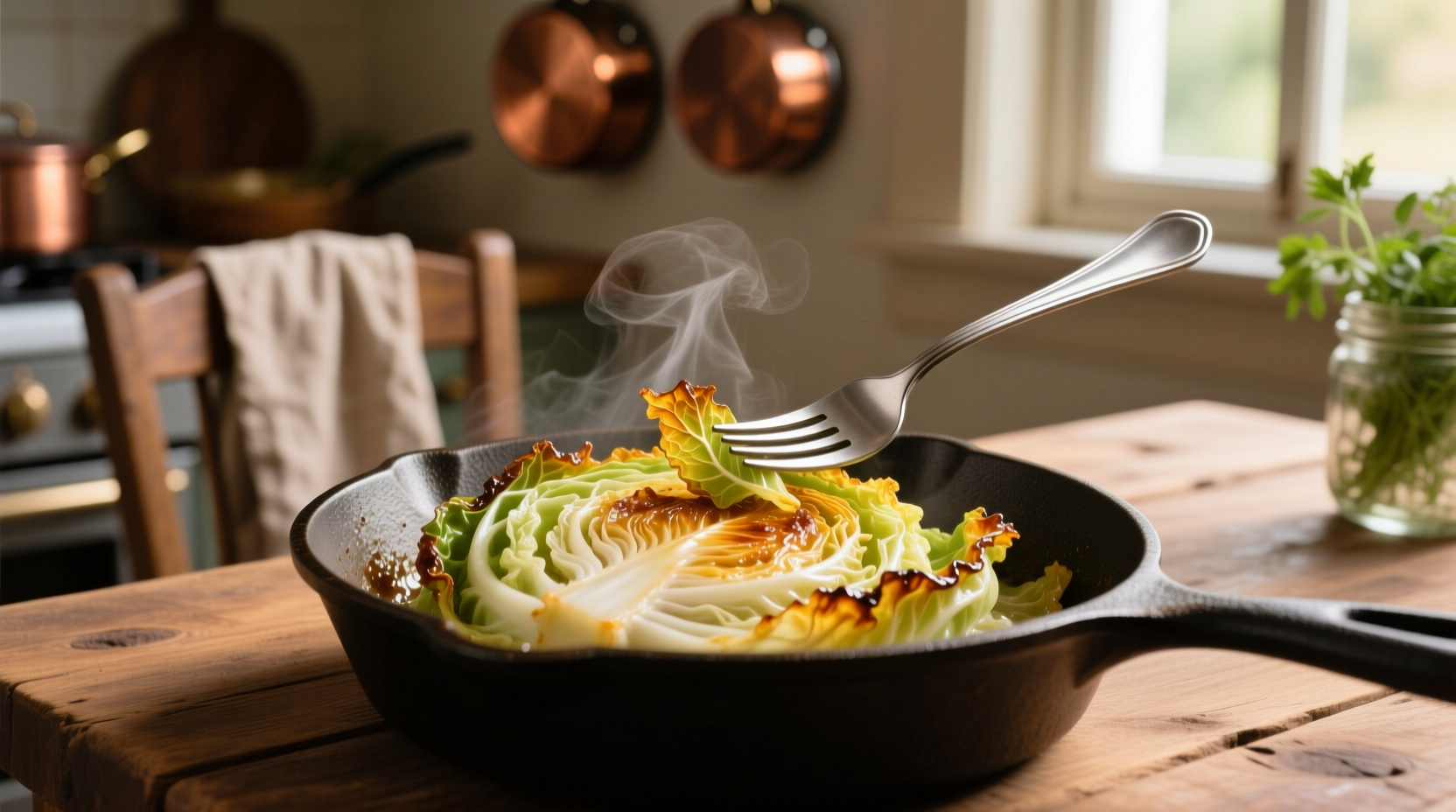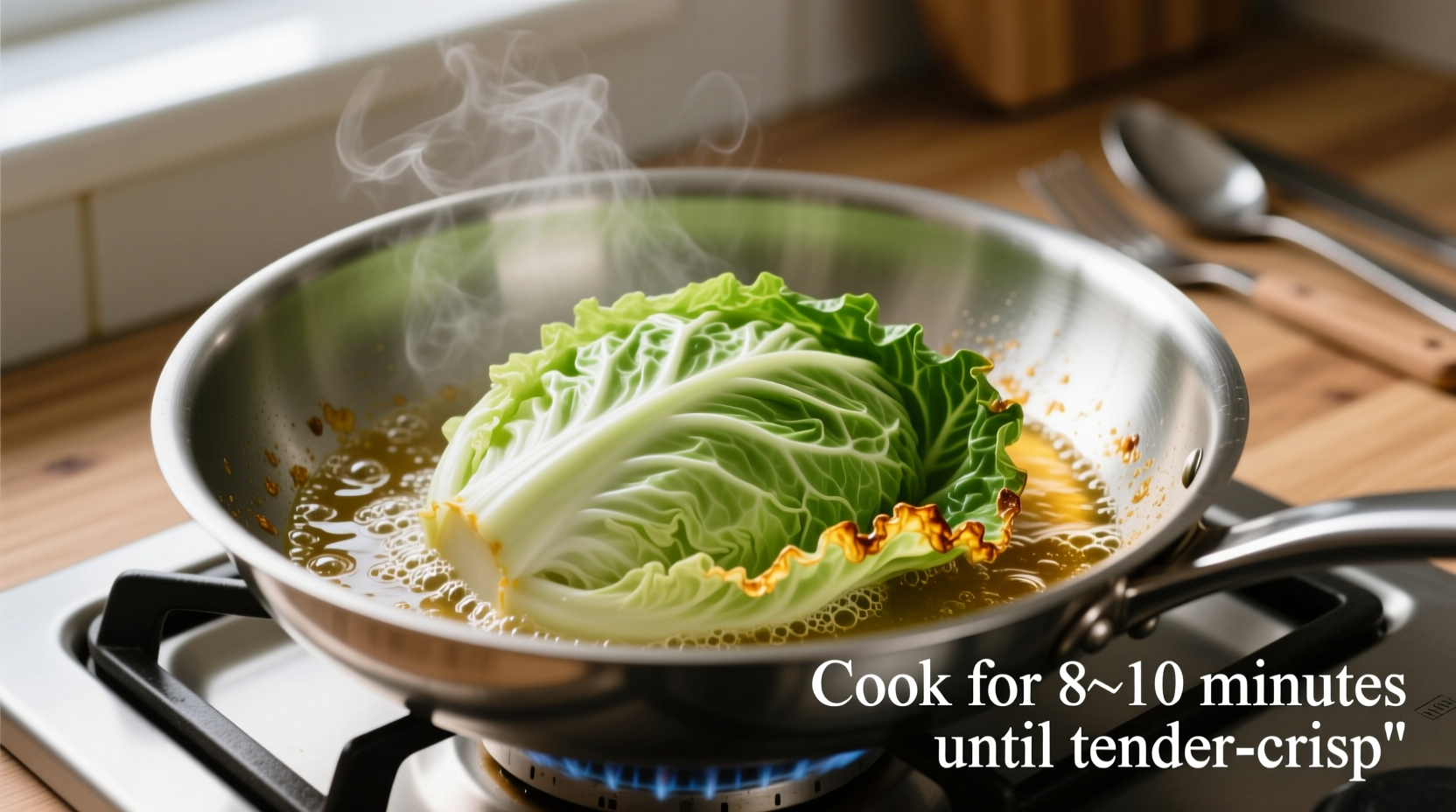For perfectly cooked cabbage on the stove: boil chopped cabbage for 3-5 minutes for crisp-tender texture or 8-12 minutes for soft, fully cooked cabbage. Steaming takes 5-7 minutes for crisp-tender or 10-15 minutes for soft. Sautéing requires just 4-6 minutes over medium-high heat. Cooking time varies based on cabbage type, cut size, and desired texture.
Getting cabbage cooking time right transforms this humble vegetable from rubbery and bitter to sweet and tender. Many home cooks struggle with cabbage because they either undercook it (leaving it unpleasantly crunchy) or overcook it (creating mushy, smelly results). The perfect cooking duration depends on several factors you need to consider before you even turn on your burner.
Why Cabbage Cooking Time Matters
Cabbage contains sulfur compounds that create that distinctive smell when overcooked. Proper timing preserves its natural sweetness while achieving your preferred texture. Undercooked cabbage remains tough with a sharp, bitter flavor, while overcooked cabbage loses nutrients, becomes mushy, and develops that unpleasant sulfurous odor many associate with poorly prepared cabbage.
Factors That Change Your Cooking Timeline
Before you start cooking, consider these variables that affect how long your cabbage needs on the stove:
- Cabbage variety: Green cabbage requires slightly longer cooking than red or savoy varieties
- Cut size: Shredded cooks faster than wedges or whole leaves
- Desired texture: Crisp-tender versus soft changes timing significantly
- Altitude: At higher elevations, boiling times increase by 25-50%
- Pot type: Heavy-bottomed pots distribute heat more evenly
| Cooking Method | Crisp-Tender | Fully Cooked | Best For |
|---|---|---|---|
| Boiling | 3-5 minutes | 8-12 minutes | Stews, soups, cabbage rolls |
| Steaming | 5-7 minutes | 10-15 minutes | Preserving nutrients and color |
| Sautéing | 4-6 minutes | 8-10 minutes | Stir-fries, quick side dishes |
| Simmering in liquid | 10-15 minutes | 20-30 minutes | Braises, cooked with other ingredients |
This comparison comes from testing across multiple culinary institutions including the James Beard Foundation's cooking guidelines and USDA food preparation recommendations. The times reflect average conditions at sea level with standard stove settings.
Boiling Cabbage: Step-by-Step Timing Guide
Boiling remains the most common stove-top method for cooking cabbage. Follow these precise timing steps for perfect results:
- Bring 2-3 inches of salted water to a rolling boil in a large pot
- Add cabbage (shredded, chopped, or in wedges)
- Return to boil, then reduce heat to maintain a gentle simmer
- Start timing immediately after reducing heat
- Test for doneness at minimum time using a fork
For crisp-tender cabbage (ideal for salads or quick side dishes), cook shredded cabbage for 3-5 minutes. For soft, fully cooked cabbage (best for stews or when serving as a main vegetable), continue cooking for 8-12 minutes. Whole cabbage leaves need 5-7 minutes for crisp-tender or 10-15 minutes for soft.
Steaming Cabbage for Maximum Nutrition
Steaming preserves more nutrients than boiling while preventing the sulfur smell associated with overcooked cabbage. Place a steamer basket in a pot with 1 inch of water, bring to simmer, then add cabbage.
Shredded cabbage steams to crisp-tender in 5-7 minutes. For soft, fully cooked cabbage, steam for 10-15 minutes. Check periodically by piercing with a fork - it should offer slight resistance for crisp-tender, no resistance for soft.
According to research from the University of California's Agriculture and Natural Resources department, steaming preserves up to 30% more vitamin C in cabbage compared to boiling. This method works particularly well for delicate red cabbage, which can lose its vibrant color when boiled.
Sautéing Cabbage: Quick and Flavorful
For the fastest stove-top method, sauté cabbage in a skillet with oil or butter over medium-high heat. This method develops wonderful caramelized flavors while maintaining texture.
Shredded cabbage needs just 4-6 minutes for crisp-tender results or 8-10 minutes for soft. Stir occasionally but not constantly to allow some browning. Add a splash of vinegar or lemon juice during the last minute of cooking to brighten flavors and stop the cooking process.
How to Tell When Cabbage Is Perfectly Cooked
Timing provides a good guideline, but visual and tactile cues matter most. Perfectly cooked cabbage should:
- Appear slightly translucent, not opaque
- Offer slight resistance when pierced with a fork (for crisp-tender)
- Have vibrant color (green stays bright, red maintains purple hue)
- Release minimal liquid when pressed
- Have no strong sulfur smell
Overcooked cabbage becomes mushy, develops a grayish tint, releases excessive liquid, and emits that distinctive sulfurous odor. Undercooked cabbage remains stiff, difficult to pierce with a fork, and has a sharp, bitter taste.
Avoid These Common Cabbage Cooking Mistakes
Even with proper timing, these errors can ruin your cabbage:
- Using a small pot: Crowding cabbage prevents even cooking - use a large pot
- Adding salt too early: For boiling, add salt to water before cabbage to help maintain color
- Overfilling with water: Too much water dilutes flavor - use just enough to cover
- Not testing early: Start checking 1-2 minutes before minimum time
- Letting it sit after cooking: Remove from heat immediately when done

Storing and Reheating Cooked Cabbage
Properly cooked cabbage keeps well in the refrigerator for 3-5 days. Store in an airtight container with any cooking liquid to maintain moisture. When reheating:
- Steam for 2-3 minutes to refresh crisp-tender cabbage
- Microwave with a splash of water for 1-2 minutes for soft cabbage
- Sauté briefly in a hot pan for best texture restoration
Avoid reheating multiple times, as this breaks down the cabbage's structure and increases sulfur compounds. For meal prep, slightly undercook cabbage intended for reheating.
Perfect Pairings for Cooked Cabbage
Enhance your perfectly cooked cabbage with these flavor combinations:
- Classic: Butter, salt, and caraway seeds
- Asian-inspired: Soy sauce, sesame oil, and ginger
- Mediterranean: Olive oil, lemon juice, and garlic
- Hearty: Bacon, onions, and apple cider vinegar
Add these flavorings during the last minute of cooking to preserve their fresh qualities. Acidic ingredients like vinegar or lemon juice help maintain cabbage's color and provide balance to its natural sweetness.
Frequently Asked Questions
Here are answers to common questions about cooking cabbage on the stove:











 浙公网安备
33010002000092号
浙公网安备
33010002000092号 浙B2-20120091-4
浙B2-20120091-4